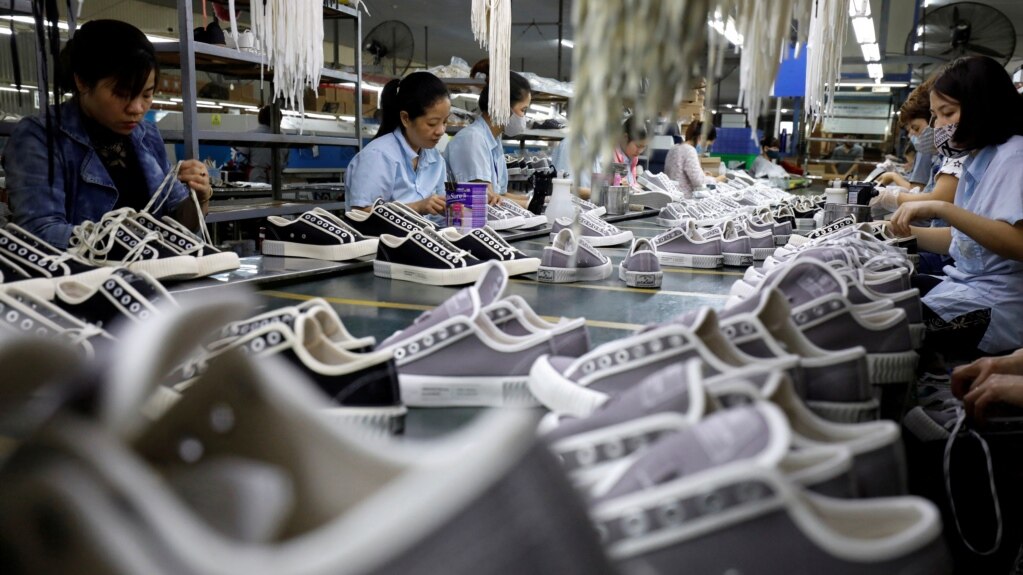As the United States increases tariffs to reduce trade with China, it has greatly increased imports from Vietnam. The Southeast Asian country, however, depends on China for much of its exports to the U.S.
The Reuters news agency recently studied information from the World Bank and economic experts. It shows that the value of China’s exports to Vietnam almost matches the value of exports from Vietnam to the U.S. in recent years.
Last year, the U.S. imported over $114 billions of goods from Vietnam. That was more than two times more than 2018 when U.S.-China trade disputes began. That increase happened as U.S. imports from China dropped by $110 billion.
Hung Nguyen is an expert in supply chains, or networks of product suppliers, with RMIT University Vietnam. He said, that in important industries such as clothing and electronic equipment, "Vietnam captured more than 60 percent of China's loss.”
However, data show that much of Vietnam’s exports to the U.S. are parts, or components, produced in China.
The Asian Development Bank estimates that imported parts account for 80 percent of the value of Vietnam's electronic exports in 2022.
The Organization for Economic Co-operation and Development said in a report that 90 percent of goods imported by Vietnam's electronics and clothing industries in 2020 were then "embodied in exports." That number, the organization said, was higher than in earlier years and far above the average in industrialized countries.
In the first three months of 2024, U.S. imports from Vietnam added up to $29 billion, while Vietnam's imports from China totaled $30.5 billion.
Darren Tay is the lead economist at the research company BMI. He said, "The surge in Chinese imports in Vietnam coinciding with the increase in Vietnamese exports to the U.S. may be seen by the U.S. as Chinese firms using Vietnam to skirt the additional tariffs imposed on their goods." He noted that could lead to tariffs against Vietnam after the U.S. presidential elections.
Vietnam now has the fourth-largest trade surplus with the U.S. That surplus is only smaller than the ones the U.S. has with China, Mexico, and the European Union.
The growing trade imbalance comes as Vietnam seeks “market economy” treatment from the United States. U.S. President Joe Biden has pushed to increase diplomatic ties.
The U.S. Embassy in Hanoi did not comment on trade imbalances. Vietnam's foreign and trade ministries did not answer requests for comment. And China's commerce ministry did not immediately answer a request for comment from Reuters.
Cotton and panels
The increase in China-Vietnam-U.S. trade takes place as investments in Southeast Asian countries rise. Companies involved in the area are moving some of their activities from China. Many Chinese companies set up new factories in Vietnam. But they still heavily depend on supplies from their homeland.
After a 2023 investigation, the U.S. Commerce Department found that some of the trade was just a way to place “Made in Vietnam” on finished solar panels to avoid tariffs.
Another reason Vietnam is getting U.S. attention is its involvement in the Xinjiang area in China. The U.S. bans imports from the area over accusations of human rights violations against minority Uyghurs.
Xinjiang is China's main producer of cotton and polysilicon, a material used to make solar panels. Both are important to Vietnamese industries. Vietnam’s clothing and solar panels accounted for about nine percent of exports to the U.S. last year. Vietnam surpassed China as the main exporter of products covered by the Xinjiang ban last year, said Hung Nguyen of RMIT.
The Biden administration has remained quiet about Vietnam's large trade surplus. Some experts say that may change after the November elections in the U.S.
Nguyen Ba Hung is an economist at the Asian Development Bank. He said it is possible that “…whoever wins may change the policy towards Vietnam.” But that would also risk increasing U.S. import costs.
I’m Mario Ritter, Jr.

